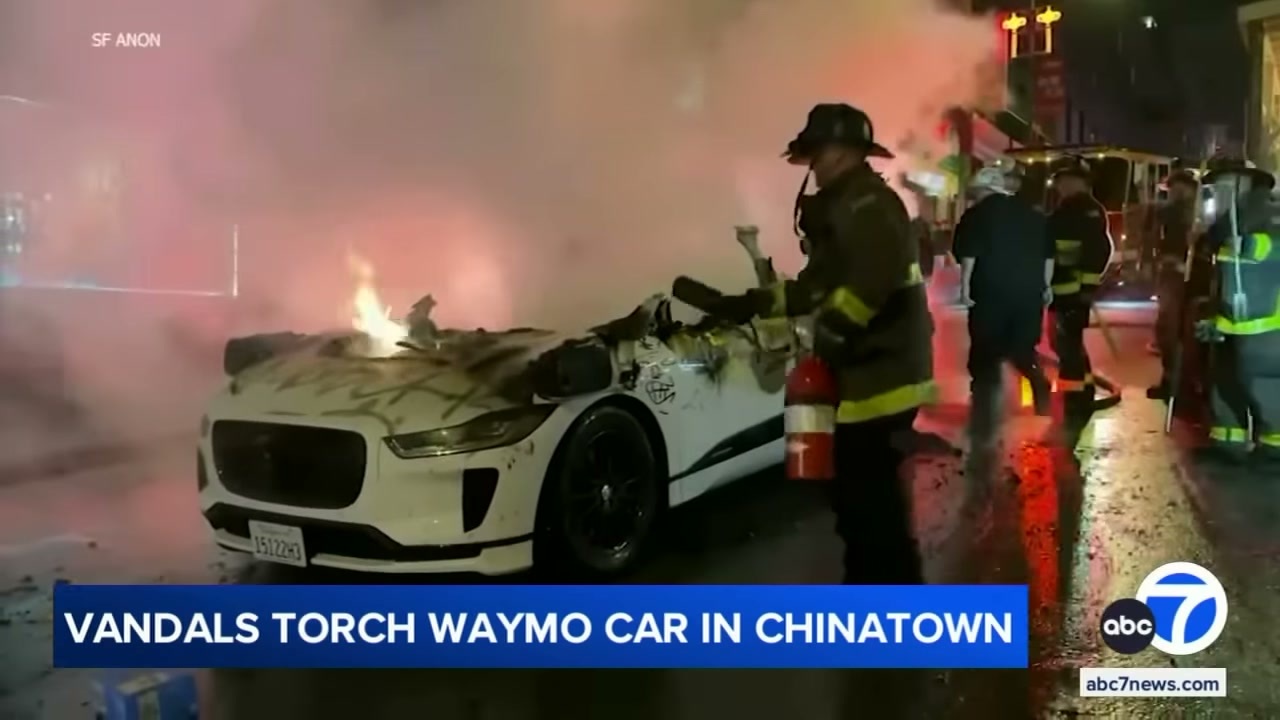This post was republished from Blood in the Machine, a newsletter about AI, big tech, and labor. Subscribe for more stuff like this.
We don’t yet know exactly why a group of people very publicly graffitied, smashed, and torched a Waymo car in San Francisco. But we know enough to understand that this is an explosive milestone in the growing, if scattershot, revolt against big tech.
We know that self-driving cars are wildly divisive, especially in cities where they’ve begun to share the streets with emergency responders, pedestrians, and cyclists. Public confidence in the technology has actually been declining as they’ve rolled out, owing as much to general anxiety over driverless cars as to high-profile incidents like a GM Cruise robotaxi trapping, dragging, and critically injuring a pedestrian last fall. Just over a third of Americans say they’d ride in one.
We also know that the pyrotechnic demolition can be seen as the most dramatic act yet in a series of escalations—self-driving cars have been vocally opposed by officials, protested, “coned,” attacked, and, now, set ablaze in a carnivalesque display of defiance. The Waymo torching did not take place in a vacuum.
To that end, we know that trust in Silicon Valley in general is eroding, and anger towards the big tech companies—Waymo is owned by Alphabet, the parent company of Google—is percolating. Not just at self-driving cars, of course, but at generative AI companies that critics say hoover up copyrighted works to produce plagiarized output, at punishing, algorithmically mediated work regimes at the likes of Uber and Amazon, at the misinformation and toxic content pushed by Facebook and TikTok, and so on.
It’s all of a piece. All of the above contributes to the spreading sense that big tech has an inordinate amount of control over the ordinary person’s life—to decide, for example, whether or not robo-SUVs will roam the streets of their communities—and that the average person has little to no meaningful recourse.
Especially when government seems incapable or unwilling to push back. In the case of the robotaxi, even after public opposition from San Francisco city officials, firefighters and emergency responders and months of activist protest, a state body, the CPUC, overrode the city’s concerns and approved allowing more on the streets. Around the same time, California governor Gavin Newsom vetoed a bipartisan bill that would have required a human operator in self-driving trucks. Shortly after both decisions, the Cruise car hit the pedestrian.
When people feel like their backs are against the wall, that their voices are not being heard, that those who profit from the deployment of invasive technologies are being given free reign—well, it creates the kind of conditions in which we might not be surprised to see more drastic measures taken up directly against those technologies.
It’s a cycle that dates all the way back to the time of the perennially misunderstood Luddites (a topic which, if you’re familiar with my work, you’ve likely heard me go on about before). At the dawn of the Industrial Revolution, textile workers took up hammers against industrialists who were using machinery to automate their jobs and shepherd work into the factory system. But they wielded those hammers as a tactic of last resort, because elites, the state, and profiteers refused to listen to the urgent pleas of ordinary people, of the working class; because democracy was off the table.
Now, more than ever, Silicon Valley should be paying attention. We all should. Because the torching of the Waymo car may well prove to be a turning point. If no one in power is going to listen to the growing chorus of people shouting their fears that big tech has concentrated too much wealth, influence, and control over their lives—or to the legion of New Luddites organizing against the excesses of Amazon, generative AI giants, and self-driving car companies—then this smoldering husk of an AI-driven robot may merely be the first.
There’s a reason that the most significant piece of torched tech in the AI era is a driverless vehicle. And it shows that we probably should have been watching more closely how the public reacted to Silicon Valley’s forays into transportation—or “the mobility space” in Valley lingo—all along. That this arena may be something of a litmus test for how much technological intrusion the public is willing to bear.
At the height of the e-scooter craze, angry citizens were throwing Birds in rivers by the dozen, burying them in the sand, and hosting Instagram accounts dedicated to the myriad ways people destroyed them. Some of that was motivated by residents who were angry that their streets and sidewalks were suddenly overrun by fast-moving, potentially dangerous machinery, who took matters into their own hands when they felt city councils were too slow to act. But the glee and carnival atmosphere of many of these dismantlings suggest the civic vigilantism was paired with, or primed by, an antipathy for Silicon Valley, too.
The reaction has been similar ever since self-driving cars have been pushed into the public sphere. In Arizona, where self-driving cars have been tested for years—and where an autonomous car operated by Uber struck and killed a woman in 2018—residents have thrown rocks at the cars, slashed their tires, and pointed guns at them. One man alone ran six different vehicles off the road. And there’s the escalating resistance in California, in both Los Angeles and, of course, San Francisco.
This is notable first for cause. These are people who did not ask for self-driving cars, did not vote to let them onto their streets and shared spaces, doing what they can to push back. It’s also notable because the mobility space is one of the few areas where Silicon Valley has pushed tangible hardware products into the public sphere, apart from consumer electronics like computers and phones. The tech industry had largely dedicated the last decade or so to its project of having software eat the world, so while the giants grew their social media platforms and app stores, the startups and unicorns were largely dedicated to pursuing "Uber for X" gig apps, big data plays, or software for smart devices.
This had the knock-on effect of limiting the physical sites of any potential revolt at the exact moment when the public was souring on Facebook, Amazon, and Uber. In the Luddites’ time, a weaver could see with his own eyes the factory an industrialist had built just outside town. They knew precisely who was driving down wages with machinery, run by underpaid laborers, that mass-produced subpar goods. When conditions became intolerable, and appeals to reform failed, the Luddites knew exactly which machines to smash to deal a blow to those profiting at their expense.
Conversely, Silicon Valley’s software-eaten world did a pretty good job of obscuring what was happening, for a while. For one thing, gig work companies removed the direct causes of your falling wages and maltreatment from view altogether. The gig worker doesn’t even have a manager or an HR person to get mad at for falling pay, unjust deactivations, or maltreatment—they were automated away.
Self-driving cars, e-scooters, and delivery robots, meanwhile, are quite clearly the products of the tech companies. They are roving mascots for Silicon Valley, and for what it is criticized and despised for: Driving tech into spaces where people don’t want it, trumpeting a desire to automate away jobs and erode work, bringing constant surveillance along for the ride. In many ways, a strike against them is a strike against Silicon Valley.
And the strike against the Waymo car is the biggest yet. Literally—those cars cost around $200,000 each, according to the New York Times. It might well be the biggest direct blow against the equipment owned by a tech company since radical student activists firebombed corporate computer labs owned by Hewlett Packard, among others, in the 1970s.
The Waymo car was barely recognizable by the time the firemen extinguished the flames. And the firsthand accounts seem to indicate this was a spontaneous event: The desire to tear this thing apart was in the air. It was not a freak, isolated act of vandalism. It started from a shared sentiment among different people in a crowd, and rapidly turned into a charged, participatory dismantling of one of Silicon Valley’s biggest products.
An eyewitness told the Autopian that the robotaxi was holding up traffic—its sensors may have been confused by a firework show—when people began to angrily notice:
There was a small traffic holdup with waymo at the front of it. Then someone in a white hoodie jumped on the hood of the car and literally WWE style K/O’d the windshield & broke it.
The crowd was shocked. People started paying attention and gathered around. Nothing happened for another 30 seconds until someone else jumped on the hood.
Then a group of people joined in affirming the behavior w/ positive feedback. Clapping etc.
That was when it went WILD. People with skateboards breaking the glass, and others graffitiing the car.
There were 2 groups of people. Folks who encourage it—and others who were just shocked & started filming.
Someone yelled out “burn it” and others cheered in support. Apparently a firework was lit underneath the car, and then another one was thrown inside, and that one caused the whole thing to catch fire and explode as bystanders hollered and took pictures and video. No one stopped it or stood in the way.
Online, the reaction was swift and predictable. The images went viral, naturally—they were pretty wild! And then came the perfunctory driverless car supporters, deriding the torchers as mindless hoodlums, casting them as backwards-looking people who knew not what they did. As Luddites.
The hoodlum argument doesn’t really hold up. There are unmanned vehicles all across the city if you consider that to mean "unattended parked cars," and I didn’t hear about crowds gathering to cheer on the grand, performative demolition of any of those. And elites have been painting people who protest or dismantle technologies that make them rich as Luddites for nearly 200 years. Then as now, those elites want to use it as an insult—to tell us that these are just knee-jerk spasms of unthinking protest against a technology that is inevitable (and in which they likely have some investment stake), all while obscuring the real grievances at play: the question of why self-driving cars have become such popular targets.
Might it be because are legitimately angry that Silicon Valley has so often ignored or papered over public outcry? Or closed off any meaningful avenues where democratic input into how it deploys its products and services might be received? Or shirked any serious accountability for its shortcomings and misdeeds?
Over the last decade, from Uber to crypto to web3 to generative AI, Silicon Valley has offered not a vision of the future, but a series of increasingly desperate and disparate pitches—a patchwork of driverless vehicles for financial gain, if you will, that each uniquely fail to consider any prospective social cost. The actual self-driving cars are but one very tangible manifestation of a "move fast and break things" ethos that now clearly registers as toxic to people who have to live among the rubble.
The original Luddites opposed "machinery hurtful to commonality," not any and all new tech. Today's self-driving car adversaries seem to be operating on a similar principle. And as the feeling of helplessness grows among those pushed around by the tech giants’ whims and schemes, the climate for resistance will only continue to ripen. The distance will shrink between the hammer and the loom—between the firework and the self-driving car.






